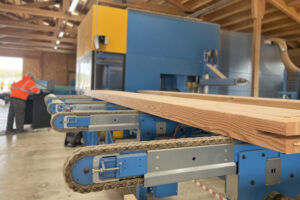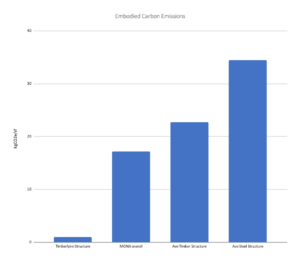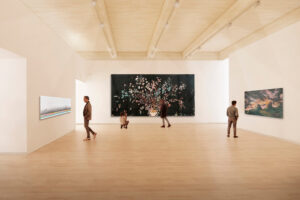Kirn Middle School Taking Shape
Recently, The Daily Nonpareil visited Kirn Middle School in Council Bluffs, Iowa. “‘It looks really nice. You guys have done a good job,’ Council Bluffs…

In 2020, BVH Architecture was selected by MONA to reconstitute the home for Nebraska art. The addition, drawing heavily on the established visual language of the region amplifies museum programs through choreographed moments of discovery. We carefully selected materials to ensure MONA’s legacy of beauty and sustainability. Among those materials is mass timber, which Timberlyne will provide.
At the end of January, BVH Architect Matt Fitzpatrick and team members from Whiting Turner took a tour of the Timberlyne Shop in Boerne, TX.

Our team was very fortunate to see the actual beams, columns, and steel connections being fabricated and finished for our project on-site in real-time. Timberlyne’s impressive new Hundegger robot and routing machine were fully displayed, creating the most complex joinery applications imaginable. We are also thankful to have met the talented technical team behind the scenes responsible for running the machines and creating the production documentation!
– Matt Fitzpatrick, AIA

Using an exposed mass timber structural system recalls an elevated yet distinct Nebraska aesthetic. Patrons will experience the warmth of the exposed wood, the subtleties of the natural material, and the evidence of MONA’s desire to perpetuate a high-performing, sustainable building. Using cross-laminated timber (CLT) in place of a different system allowed the structural system to be nearly carbon neutral on this project.
BVH previously posted a biophilic overview of the human health and beauty of biophilic design. Mass timber is a rich material from nature—connecting us to biophilic patterns found in wood. Humans prefer natural materials over synthetic recreations because we can discern the difference. The exposed wood’s textures, colors, and patterns can only be achieved through natural processes.
In addition to their biophilic health benefits, trees sequester carbon emissions (CO2) during their lifecycle. When we harvest wood for use in our buildings, the timber we use still contains some of this stored carbon, effectively sequestering it for the lifespan of the building. After its use in a building, timber can continue storing carbon as long as the timber remains intact, whether reused or recycled.
Quantifying this stored carbon—what our industry calls embodied carbon—is an increasingly important and needed component to understanding a building’s environmental impact over its life cycle. Each material used for our buildings impacts our environment from their extraction, manufacturing, and installation—which occurs in air and water pollution, water and energy consumption, and the carbon emissions that impact global warming. However, mass timber or other biological materials can reduce and potentially eliminate significant carbon emissions.

For MONA, BVH evaluated the carbon emissions of MONA’s new construction and renovation. Measured in kilograms of carbon dioxide emissions per square foot (kgCO2e/sf), the average embodied carbon of a steel framed structure is 34.5 kgCO2e/sf, whereas a timber structure averages 22.7 kgCO2e/sf. In addition to timber columns and beams, MONA is utilizing cross-laminated timber (CLT) decking instead of metal decks for the floor structure. Evaluating the total mass of timber’s embodied carbon from the beams, columns, and decking, including the steel connections and miscellaneous steel structural elements, totals one (1) kgCO2e/sf, nearly carbon neutral. Finally, for an overall perspective of carbon emissions, we incorporate the whole building enclosure, substructure, and interior finishes into the analysis achieving carbon emissions of 17 kgCO2e/sf.
Exploring the carbon emissions of our work aligns with BVH’s core value: the pursuit of knowledge. Carbon emissions and environmental impacts of our building designs are measurable and vital to understand and reduce. Our excitement is twofold: a mass timber structure can reduce the overall carbon footprint, and restoring the existing building further avoids carbon emissions. Patrons of MONA will not see the carbon emissions, but they will experience the beautifully biophilic mass timber structure alongside Nebraska-inspired art.
